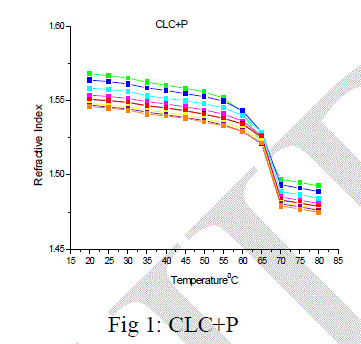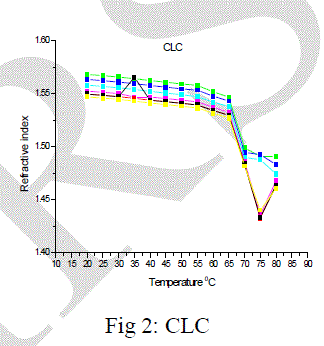ISSN ONLINE(2319-8753)PRINT(2347-6710)
ISSN ONLINE(2319-8753)PRINT(2347-6710)
| Rita A. Gharde*, Jyoti R. Amare, Madhavi S. Pradhan, Santosh A. Mani, Department of Physics, University of Mumbai, Mumbai, India |
| Related article at Pubmed, Scholar Google |
Visit for more related articles at International Journal of Innovative Research in Science, Engineering and Technology
We report the determination of refractive indices of polymer dispersed liquid crystal composite within visible spectral range 404-706nm for various temperatures. The droplet domain formation effect in polymer liquid crystal composite system with variation of different polymer dispersed in liquid crystal and pure liquid crystal has been studied. The optical parameters due to scattering by sapphire prism have been measured for pure liquid crystal and polymer dispersed liquid crystal. It is found that the optical anisotropy of polymer dispersed liquid crystal composite system is greatly changed by polar order present in the polymer droplet environment. The scattering is due to both reorientation and thermal effects. The wavelength and temperature dependent refractive indices are fundamentally interesting and practically important for optimizing display performances and other photonic devices employing LCs such as high temperature gradient LCs, high thermal tunable LCs, and photonic liquid crystal fibers
Keywords |
| Liquid crystal, Polymers, Refractive Indices, and Cauchy’s constant. |
INTRODUCTION |
| Liquid crystals are states of condensed matter whose symmetries lie between those of three dimensionally periodic crystals and isotropic liquids [1-3]. Thermotropic liquid crystalline phases are exhibited by large number of organic compounds whose molecules have anisotropic shape. The soft nature of the medium, coupled with anisotropic optical properties gives rise to many electro-optic effects at relatively low voltages. These are exploited in liquid crystals displays (LCD) which are the lowest power consuming flat panel devices and used in all calculators, laptop and palmtop computers. Liquid crystal can be classified into three different groups – nematic, smectic, and cholestric depending on the level of order in their molecular structure. Liquid crystals in the nematic group are most commonly used in LCD production because of their physical properties and wide temperature range. Polymer dispersed liquid crystals (PDLCs) are useful for displays, [4-7] tunable wavelength filters, [8-10] tunable liquid crystal lenses, and [11-12] polarization independent phase modulation. In a PDLC, the refractive index difference between the LC droplets and polymer matrix plays an important role in determining the voltage- off and voltage-on state transmittance. In a normal mode PDLC the droplet size is controlled at ~1 μm, which is comparable with the visible light wavelength. The index mismatch between the LC and Polymer matrix effects the light scattering capability. For a given droplet size, the larger index mismatch, the higher the light scattering. Therefore the preferred LC material for PDLC is not only high birefringence but also good match between refractive index of LC and polymer. In this paper we compare refractive index of polymers with liquid crystal and doped liquid crystal. |
MATERIALS AND METHODS |
| Polymer dispersed liquid crystal is prepared by encapsulation method in proportion (20:80). The mixture is kept in the ultrasconicator bath for half an hour for well and uniform mixing, and kept open for a day. |
| 1. REFRACTIVE INDEX MEASUREMENT: |
| The refractive indices were measured by the multiple wavelengths in the temperature range of 200C - 800C. |
| 2. CAUCHY COEFFICIENT: |
| Cauchy formula is an empirical relation between Refractive index and wavelength of light for particular transparent material. The most general form of Cauchy’s equation is |
 |
| Where n is refractive index, λ is wavelength, A, B are coefficients that can be determine for given material for measured refractive indices at known wavelengths. |
| 3. DISPERSIVE POWER: |
| Index of refraction increases as wavelength decreases. The rate of increase became as shorter wavelength and hence it is normal dispersions. All transparent substances show normal dispersion in the visible region. In general, greater the density of substance, the higher its index of refraction and its dispersion. Dispersive Power (ω): |
 |
EXPERIMENTAL RESULTS |
| 1. REFRACTIVE INDEX MEASUREMENT: |
| These are the graph of Temperature vs. Refractive Index CLC, CLC+P, CLC+P, NLC, NLC+P, NLC+M |
 |
 |
 |
| The refractive indices of mixtures were found. These refractive indices were compared with R.I. of pure of LC material. The linear decrease in R.I. with temperature is due to the isotropic nature. As the temperature increases, the density of most of the isotropic organic compounds decreases which in turn, causes the R.I. to decrease linearly. The R.I. varies with linearly because different wavelengths interfere to different extent with the atoms of the medium. We compare the wavelength dependent R.I. of pure and doped LC at 400C. Doped nematic liquid crystal found to be more effective then doped cholestric liquid crystal. From the graph it has been confirmed that above dispersion is normal dispersion and hence calculated Cauchy’s coefficient for the same, which are in accordance with pervious investigation. Dispersive power are almost constant over a temperature range of 800C to 200C for doped LC. |
CONCLUSION |
| We successfully study various characteristics of LC. The sensitivity of Cholestric LC and Nematic LC is enhanced by doping with polymer and monomer. Doped sample switch to a transparent state, when heated over the N-I transition temperature. Since the refractive index of isotropic LC is similar to the refractive index of nematic LC, which is match to refractive index of doped sample. Such a thermal switching effects can be used in the projection displays. |
References |
|